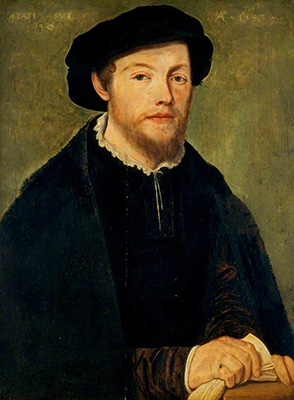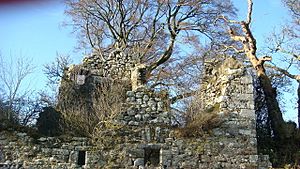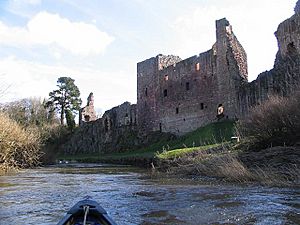Alexander Crichton of Brunstane facts for kids
Alexander Crichton of Brunstane (died before December 1558) was a Scottish landowner, also known as a laird. He was a Protestant who supported the idea of Mary, Queen of Scots marrying Prince Edward of England. He also supported plans to remove Cardinal David Beaton from power. In old letters and documents, Alexander is often called "Brunstane," which was the name of his family's land. The first House of Brunstane was near Penicuik. Another Crichton property at Gilberstoun, near Portobello, Edinburgh, later became known as Brunstane.
Contents
Alexander Crichton's Life and Work
Early Travels to France
In 1539, Alexander Crichton traveled to France. He carried royal letters and worked for Cardinal Beaton. In February 1540, he returned to Scotland. A storm forced his ship to stop in an English port.
The English ambassador in Scotland, Ralph Sadler, tried to cause trouble for Cardinal Beaton. He showed James V of Scotland some letters taken from Brunstane's bag. These letters were meant to make the Cardinal look bad. However, King James V defended the Cardinal. He said the Cardinal had his own spiritual power in Scotland, separate from the King's power.
Later, King James and Ralph Sadler compared the captured letters with the Cardinal's own copies. They found some differences. King James thanked Sadler and his uncle, King Henry VIII. But he did not find fault with the Cardinal.
Messages and Royal Tennis
Alexander Crichton remained in the Cardinal's good favor. He sailed with him to France in 1540. He returned to Scotland in 1541 before the Cardinal. He met with King James V. On April 3, 1541, the King, Crichton, and the secretary, Thomas Erskine of Haltoun, played tennis at St Andrews.
In November 1542, Crichton sailed to France from Dumbarton. He was handling money owed to the Cardinal and Mary of Guise. He returned with money for King James V from Francis I of France. Later, he was accused of keeping some of this money. An English spy reported that Alexander's return in December 1542 brought "little comfort." On November 19, 1542, Alexander and his son John received a new land agreement. This was a reward for Alexander's work and costs in France.
War of the Rough Wooing
Supporting English Plans
After King James V died in December 1542, Regent Arran ruled Scotland. By this time, Alexander Crichton of Brunstane was receiving money from England. He supported England's political and Protestant religious goals in Scotland.
In July 1543, Cardinal Beaton and his friends opposed Regent Arran. They also opposed plans to be friendly with England. They gathered about 6,000 armed men at Linlithgow. Mary, Queen of Scots was staying at Linlithgow Palace at that time.
Alexander Crichton told Ralph Sadler that this rebellion aimed to break the peace with England. This peace was part of the Treaty of Greenwich. This agreement said that Mary, Queen of Scots, would marry the English Prince Edward when she was old enough. Sadler reported that Crichton and George Douglas of Pittendreich saw the rebellion as against the marriage plan. However, the Earl of Glencairn said the rebels liked the marriage idea. They were only concerned about when Mary would go to England.
The Governor and the Cardinal later made peace. Crichton continued to write to Ralph Sadler. In November 1543, Sadler had to move from Edinburgh to Tantallon Castle. The English marriage plan was losing support in Scotland. Brunstane wrote that he was still finding people to support England's plans. He mentioned John Charteris and John Sandilands of Calder. He convinced Sandilands's neighbors to refuse money from France.
Plans Against the Cardinal
In March 1544, at the start of the Rough Wooing war, Brunstane met secretly with the English Berwick Herald, Henry Ray. This meeting was in Edinburgh. Brunstane gave him letters he had written for Henry VIII.
In April 1544, Brunstane suggested a plan to deal with Cardinal Beaton. At the same time, Lord Hertford was planning an invasion. This invasion led to the burning of Edinburgh in May. Brunstane's offer was not accepted right away. But he was given a secret code to use in his letters to England.
Brunstane sent a Scot named Wishart to Lord Hertford on April 17, 1544. Wishart carried Brunstane's plan for the Cardinal. Hertford noted two main goals for Henry VIII:
- The Laird of Grange, the Master of Rothes, and John Charteris would try to capture or remove the Cardinal. This would happen when he traveled through Fife.
- If King Henry VIII would pay for 1,000 or 1,500 men for a month or two, they would do more. When the English army was in Scotland, they would destroy the abbey and town of Arbroath. They would also capture those who opposed friendship between England and Scotland.

Historian Charles Rogers wondered about the identity of Brunstane's messenger, "Wishart." Rogers believed it was not the famous Protestant preacher George Wishart. He thought it was a young man, John, the eldest son of John Wishart of Carnbeg.
According to a report by Eustace Chapuys, Brunstane tried to speak to Lord Hertford. This happened at Leith on May 5, 1544, during Hertford's attack on Edinburgh. One of Hertford's guards shot Brunstane in the leg with an arrow. The next day, Brunstane returned with safe-conduct papers. He said he had offers from Scottish lords. But Hertford had orders not to talk with any Scot. Hertford wrote that Crichton was with Arran's forces. He retreated with them to Linlithgow. Before May 15, Crichton sent a message to Hertford. He said he planned to go to London because he could no longer stay in Scotland. He went to London in June 1544. He carried a letter for Henry VIII from George Douglas of Pittendreich.
Brunstane went back to London in November 1544 for Arran's business. He discussed payments for captured ships. In July 1545, Brunstane again offered to capture or remove the Cardinal. Henry VIII would not directly support the action. But Ralph Sadler wrote to Brunstane, saying it would be "an acceptable service to God to take him away." Sadler promised Henry VIII would reward those who did it. He also suggested that George Douglas of Pittendreich and the Earl of Cassilis should join Brunstane's plan. Nothing happened at this time.
International Connections
Mary of Hungary, who governed the Netherlands, believed France was not sincere. She thought France encouraged the English marriage plan. This was to gain an advantage in talks with England about Boulogne. Boulogne had been captured on September 13, 1544.
There was another plan. Brunstane wrote to Sadler on October 20, 1545. He asked for an urgent meeting at Berwick upon Tweed. George Douglas of Pittendreich had told him something important. The Lords of the Parliament of Scotland had signed an agreement. It was for Mary, Queen of Scots, to marry James Hamilton, the Governor's son. James Hamilton, called the "Master of Hamilton," had been held by the Cardinal at St Andrews Castle since October 1544. Alexander heard that the Cardinal was trying to bring the queen to St Andrews. But he doubted the Cardinal truly wanted the Hamilton marriage. He thought Mary of Guise was only pretending to be angry about the plan.
Sadler returned to London. There is no record of a meeting with Brunstane at Berwick. The diplomat Johannes Sturm wrote to the English secretary of state, William Paget, on December 4. He shared news of talks about the new marriage plan in France. Sturm realized the Hamilton marriage would disrupt the Anglo-French peace talks. He advised Paget that they should stop it.
Wishart's Arrest and Cardinal's Death

In 1546, the preacher George Wishart stayed at the House of Brunstane. The Earl of Bothwell arrested Wishart on January 16, 1546. This happened at the house of Brunstane's friend, John Cockburn of Ormiston. Later that night, Arran's men came for Ormiston, Brunstane, and young Sandilands of Calder. Alexander escaped. He ran in the frost through Ormiston wood and reached Tantallon Castle. George Wishart was taken to St Andrews and executed.
On May 16, 1546, a summons for treason was issued against Alexander. The Cardinal was removed from power at St Andrews Castle. This was done by a group of Protestant landowners from Fife. These men included those Alexander had suggested. These landowners, known as the Castilians, held the castle. They also held the Governor's son, James Hamilton, as a hostage.
Scottish Approval of the Treaty of Ardres
The long-awaited Anglo-French Treaty of Ardres (or Campe) was finished on June 7, 1546. Scotland needed to approve it to make it final. The Scottish Parliament had continued to summon Alexander Crichton for treason. But this action was stopped for unknown reasons on August 4. The Scottish Parliament approved the Treaty of Ardres on August 14, 1546.
The Governor and Mary of Guise continued their rivalry. There was an argument over who should take Scotland's approval to London. Adam Otterburn wrote to Mary of Guise with news. He said Lord Ruthven, the secretary David Paniter, and Arran's half-brother, the Abbot of Paisley, had set out. Alexander Crichton of Brunstane went with them. But they were called back after a change of plans.
The Spanish Empire pushed for the approval. Scottish captains were attacking Flemish ships without punishment. Finally, Henry's Welsh diplomat Edward Carne showed the Scottish approval. He showed it to Mary of Hungary's administrator in Brussels, President Lodewijk van Schore, on September 10. Schore pointed out its weaknesses. He noted that Arran was attacking St Andrews Castle. Mary of Hungary understood that the Empire was still at war with Scotland despite the treaty. She believed Arran's government delayed peace with the empire. This was because the situation stopped Henry from sending military help to the Protestants in St Andrews Castle.
Brunstane Supports England

The English Privy Council, a group of royal advisors, approved payments to Brunstane in 1546. One payment in April was for three months' pay for 100 horsemen. In October, his servant Cockburn received permission to carry satin cloth across the border for his home. The English border warden William Eure had already given him money. He was an "Assured Scot," meaning he had promised to support England.
After the battle of Pinkie on September 10, 1547, Brunstane traveled with the English Norroy Herald, Gilbert Dethick. They carried messages between the Privy Council of Scotland and Mary of Guise at Stirling Castle and Lord Hertford. The English commander Grey of Wilton took over Haddington. He also placed soldiers in nearby landowners' houses in East Lothian. Alexander and John Cockburn held the Houses of Ormiston, Saltoun, and Brunstane for England.
Alexander and Ormiston waited for a chance to capture Edinburgh Castle. They wanted to hand over the Governor of Scotland, Regent Arran, and his half-brother, John Hamilton, to the English. These men had replaced Alexander's relative Robert Crichton as Bishop of Dunkeld. They also wanted Grey of Wilton to capture and place soldiers in the Earl of Bothwell's house at Hailes Castle. They wrote together to John Luttrell, the English commander of Broughty Castle, on January 17, 1548. They asked him to allow fishermen from Crail to supply them.
The New Fortification
Regent Arran brought four cannons from Edinburgh Castle at the end of February. He captured the houses of the three Lothian landowners. Brunstane and Ormiston were declared traitors. The Scottish Privy Council ordered the destruction of Brunstane, Gilberstoun, and Ormiston.
In March 1548, workers were hired to remove the roof from Brunstane House. The roof timbers were taken apart and moved to Edinburgh. The woods were cut down. Ten gunners with culverins (cannons) protected the workmen. The wood and stone from the house were used to build a new part of Edinburgh Castle. This new part was called the Spur fortification. It was designed by Migliorino Ubaldini. Ormiston's brother, Ninian Cockburn, called it "yon neu blok hous" (that new blockhouse). Goods were also taken from Alexander's house at Penicuik.
On April 6, Grey of Wilton reported that Alexander's house had not been burned. But he said: "Indeed! the top is pulled down. As much of the stone as was liked, which was ready to build, was carried to Edinburgh. His young trees were cut up, and everything was handled worse than if it had been with fire."
Alexander stayed at Nunraw. He, Ormiston, and their friend, Hugh Douglas of Longniddry, remained in Lothian. They had 150 English horsemen with them. Grey of Wilton told Brunstane and Ormiston that he hoped to capture George Douglas. They kept his secret. Following Grey of Wilton's advice, Edward VI paid the two landowners for their losses. These losses were caused by military actions and supplying Haddington, which the English held.
Heir Restored
Alexander was declared a traitor by the Parliament of Scotland on December 14, 1548. This was for his actions in January. He had helped Grey of Wilton, held the House of Saltoun, and convinced Scottish people to form groups against Mary, Queen of Scots.
After Alexander's death, which happened before December 5, 1558, his son John Crichton got his lands back. The treason charge was removed because Alexander was out of the country at the time of the charge. The same happened for John Cockburn of Ormiston on the same day.
John Crichton strongly supported the Lords of the Congregation during the Scottish Reformation. Like his father, he was called the "Laird of Brymston" (Brunstane) in English letters. On January 23, 1560, he rode into Scotland to Glasgow at night. He brought letters from the English court to the Protestants. He was then sent to Fife to ask the lords to come for the talks about the Treaty of Berwick. John Crichton rebuilt Brunstane Castle at Penicuik in 1568. The date was carved over the entrance.
Images for kids
-
Alexander Crichton of Brunstane offered to raise Scottish troops and destroy Arbroath for Henry VIII.
-
Alexander Crichton of Brunstane was with the preacher George Wishart when Arran's men came to arrest him.
-
Brunstane Castle near Penicuik.
-
Alexander Crichton of Brunstane planned to capture the Earl of Bothwell's castle at Hailes.
See Also






